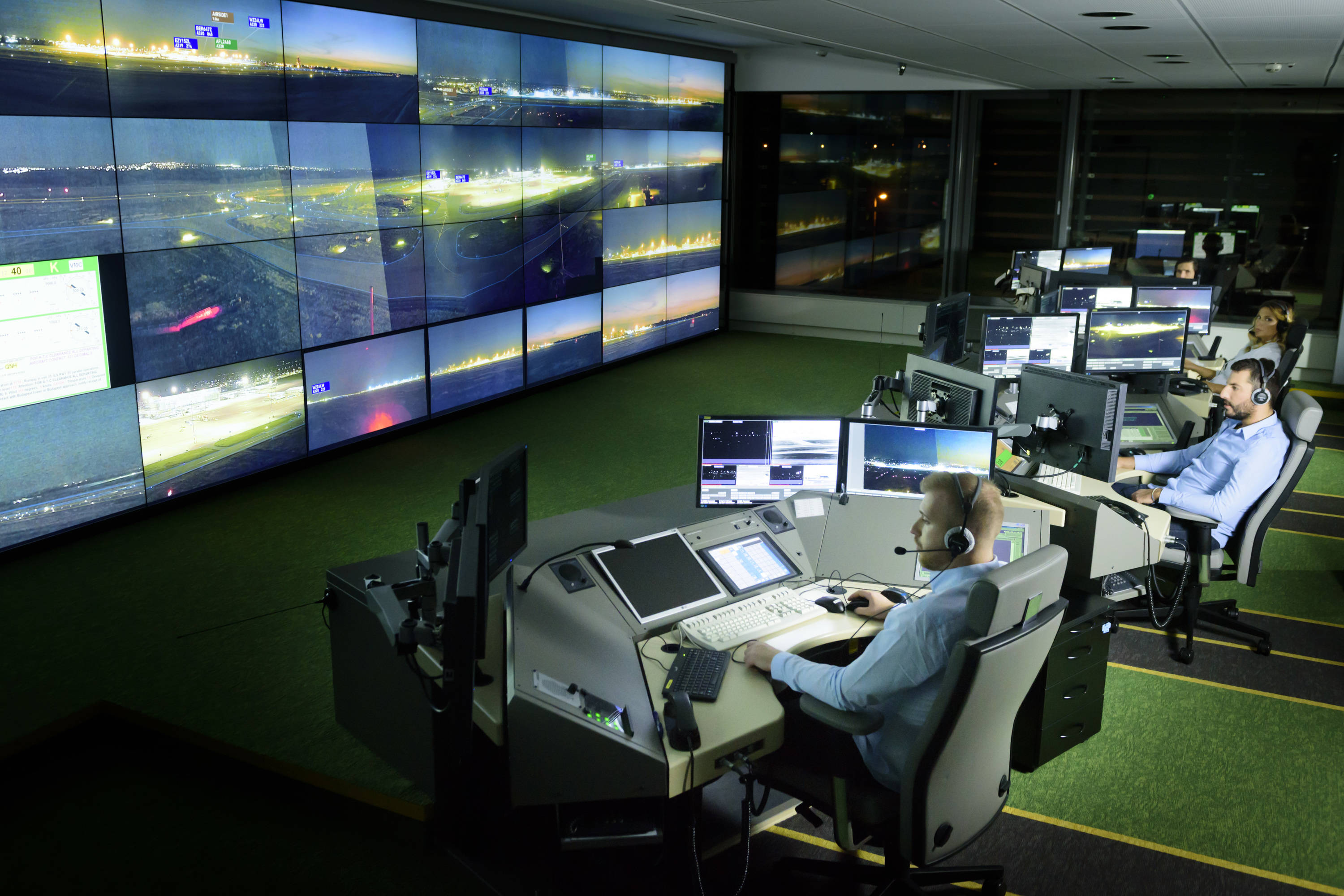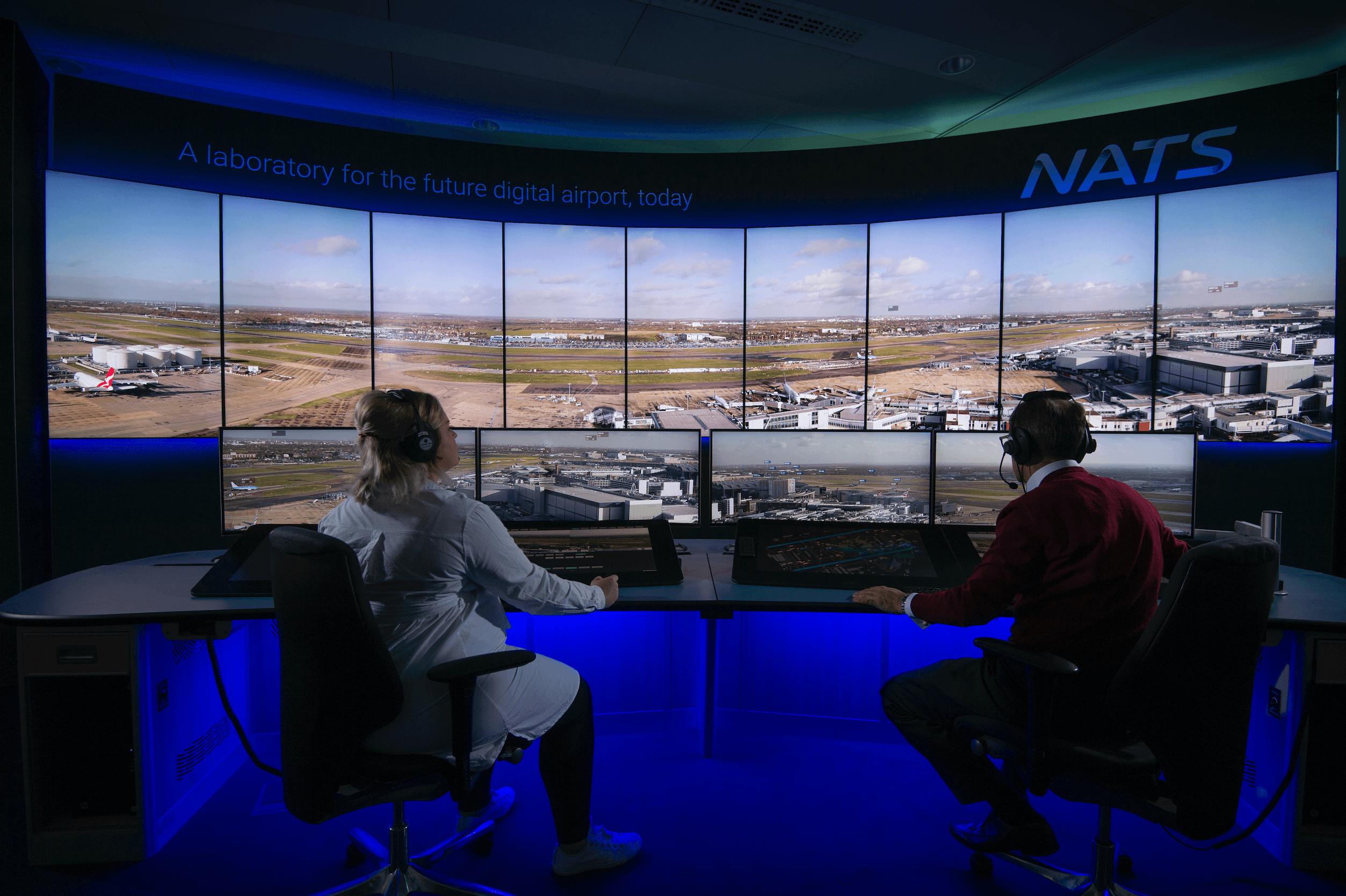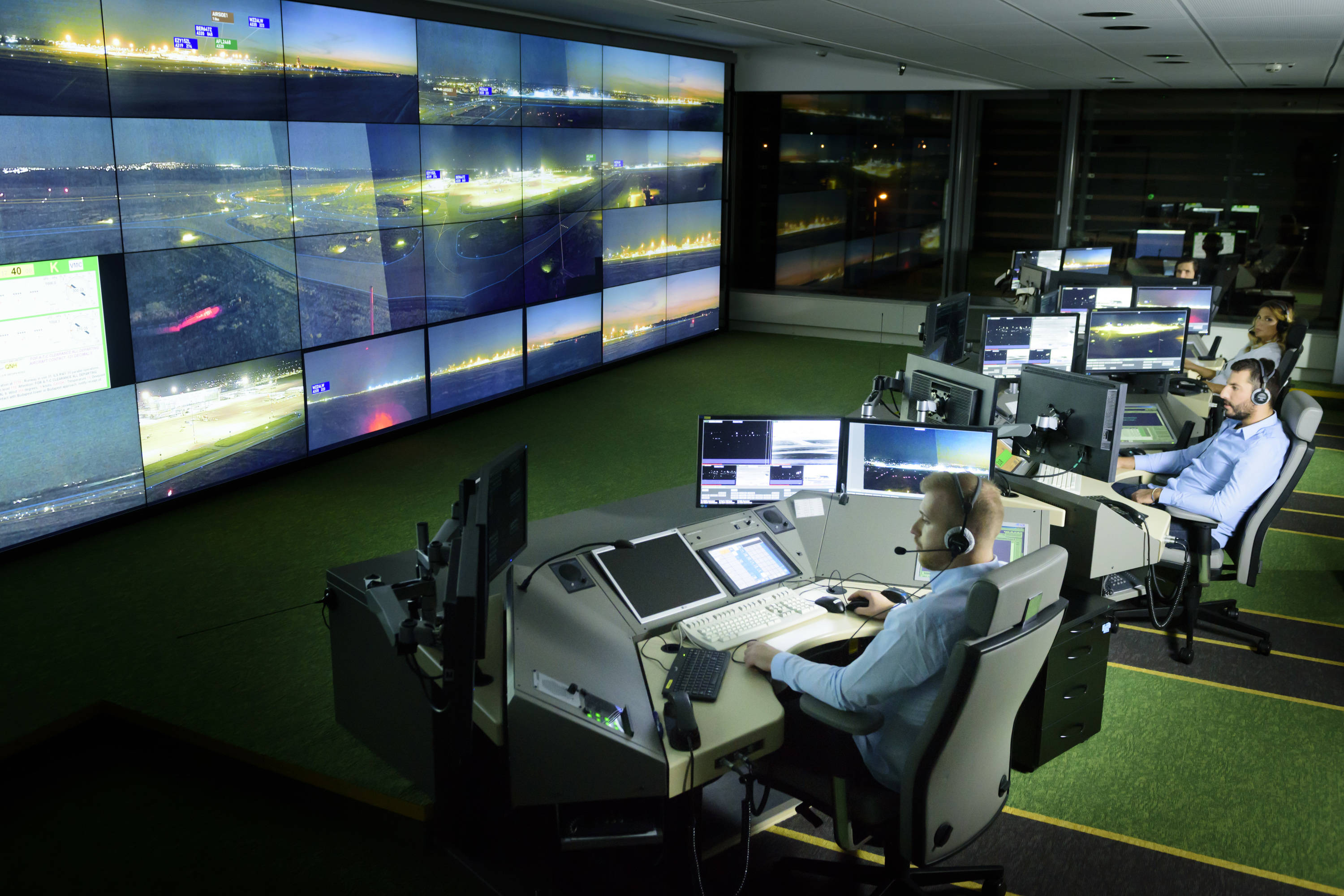


Neil Bowles, Vice President, Business Development, Searidge Technologies and Csaba Gergely, Senior ATM Adviser, HungaroControl explore digital towers in the light of the COVID-19 pandemic.
Digital towers
come of age

Digital tower solutions for medium and large airports need to enable air traffic controllers to control larger numbers of movements and greater traffic complexity safely and efficiently.
Such solutions can include the traditional out-the-window view, but the greater traffic volumes require additional, distributed camera views that enhance the controllers’ situational awareness of critical zones within the maneuvering area and nearby airspace. Cameras placed near runway thresholds would provide approach monitoring, which enables the early detection and recognition of aircraft on final approach and advanced features such as zoomed views of landing gear.
The ability to harness digital air traffic management (ATM) data within the digital tower is also vital. Data from systems such as Advanced Surface Movement and Guidance Control Systems (A-SMGCS) is integrated and displayed as flight data labels, providing visual augmentation of the displayed views. At busy airports, such data can be used to enable automation of air traffic control (ATC) support functions, such as runway sequencing and ground control.
Artificial Intelligence (AI) applications can further support operational resilience and capacity. Hold line surveillance – a runway safety net capability that utilises AI-enhanced tracking and detection – has been successfully trialed at London Heathrow Airport and conceptually proven to enable operational resilience and maintain capacity in low visibility conditions.
Other evolving applications of the Digital Tower 2.0 support efficient ramp operations. A digital tower can enable operational data sharing between key stakeholders such as ATC and airport and airline operations. Virtual ramp control can be performed from the same workstations and even the same operations room as ATC, promoting operational efficiencies and best practices.
Ramp operations can also benefit from better understanding of the various processes comprising the aircraft turnaround. Digital timestamps of turnaround activities can highlight inefficiencies and enable improvements for multiple stakeholders of Airport Collaborative Decision Making (A-CDM).
Digital towers have become an established technology solution for airports and ANSPs. They are already operational in several countries and ANSPs are developing applications beyond the remote control of small, low volume airports and realising business cases for medium and large airports too.
One of the key elements in the digital tower business case is resilience and contingency. A contingency digital tower will accommodate multiple controller positions as found in the traditional tower and high levels of capacity in fallback situations, providing business resilience.
“While a conventional tower is a single point of service provision, a remote tower can offer a second full-scale solution that is independent and separated from the physical tower,” said Csaba Gergely, HungaroControl’s ATM adviser and remote tower technology expert. “This assures business continuity and resilience.”
Other typical reasons for operating from a contingency tower include unplanned outages. However, an unexpected benefit has been to utilise the digital tower as part of the COVID-19 crisis response.
The downturn in traffic during the recent crisis has created a problem for ANSPs, namely how to ensure ATC staff maintain their skills while handling reduced traffic levels.
Typically, ATC teams train in their aerodrome simulator, but how do you replicate the camera views and systems from a digital tower? Now, ANSPs have the option to integrate simulator functionality with their digital tower system, enabling key teams to maintain operational skills in a high-fidelity replication of the digital tower environment, including 3D replication of augmented and zoomed in views.
Business resilience

Csaba Gergely
HungaroControl’s ATM adviser and remote tower technology expert
“While a conventional tower is a single point of service provision, a remote tower can offer a second full-scale solution that is independent and separated from the physical tower, this assures business continuity and resilience.”
Similar to other parts of the world, air traffic demand in Hungary was hit hard by the coronavirus pandemic. On the 12 April, traffic was down 93% compared with 2019, a record low. Liszt Ferenc International Airport lost more than 99% of its passengers, a daily average below 300 passengers, which is in stark contrast to the 44,000 passengers who travelled through the airport’s terminal every day in 2019.
HungaroControl’s operational response during the pandemic centred on the digital tower at Liszt Ferenc International Airport, which has been in operation since 2017.
HungaroControl’s digital tower is a use-case for this technology’s application beyond small airports and low complexity operating environments, demonstrating how this technology can be extended to serve medium-sized airports and some of the world’s largest hubs.
More importantly though, the digital tower is fulfilling its true use-case not only as a contingency facility but as a second full-capacity location for service provision as a line-of-defence against the COVID-19 pandemic.
Even with the reduction in air traffic, the provision of safe and efficient air navigation services remains critical to facilitate ongoing cargo and repatriation operations.
Nonetheless, the health and safety of air traffic controllers is of utmost importance to assure service continuity. Unlike other ANSPs who do not have a true back-up facility, HungaroControl’s digital tower is demonstrating its value in supporting contingency operations.
Gábor Menráth, Head of Terminal Control Department at HungaroControl explains: “We have physically separated our tower controllers who operate on 12-hour shifts. The nightshift works from our physical tower at Budapest Airport and the dayshift from our remote tower at HungaroControl’s head office. After each shift, a complete decontamination is carried out and we made sure the two groups do not meet each other. This made sure that tower operations can be performed even in the harshest pandemic situations.”
In addition to tackling the crisis and change in operating conditions, the experience helped to identify enhancements that can only be discovered when contingency operations become a reality.
HungaroControl’s response
At London Heathrow Airport, Searidge and NATS together deployed a world-first digital tower “laboratory” to enable cooperation between the Searidge team and NATS ATC teams.
The objective is to validate solutions to upcoming developments at Heathrow, such as airport expansion and enhanced tower contingency, and to co-create solutions to known issues, such as lost capacity when visibility is reduced due to low cloud. The hold line surveillance system was developed with operational and human factors input and the intention is to provide advisory data to ATC within the existing tower operation.
Meanwhile, the largest digital tower implementation in the world is under way at Singapore Changi Airport. The Civil Aviation Authority of Singapore (CAAS) has been working with NATS and Searidge to develop what is termed the Smart Tower Prototype (STP), although it is a prototype in name only as the system comprises over 100 camera sensors and redundant display views.
Integrated data from ATM and airport surveillance systems is being deployed alongside new functions such as heads-up display of automated binocular tracking, through pan-tilt-zoom camera sensors.
The system is now being used for shadow mode operations and all of the working positions in the main control tower are available in the STP, enabling electronic hand-off of traffic between the traditional and digital tower operations, with support for training and regulatory processes also included.
Large airports
It is clear that the business case for digital towers has evolved, and innovative ANSPs will be able to add crisis management and response to the ever-increasing use cases for digital towers.
As the aviation industry emerges from the current crisis and prepares for a new normal, digital tower operations should be at the forefront of ANSP and airport planning.
Conclusion

Successful ATM system deployment is dependent on connecting humans with technology. There are many advanced technologies, but true transformation of service delivery is only successful if we reach a symbiosis between humans and technology. With extensive experience in this field, HungaroControl provides tailored consulting and advising services for remote tower deployment from concept to operation.
For some, the idea of a digital tower means recreating what you already have in a remote location. But the reality can be so much more. NATS and Searidge Technologies work with airports on their digital transformation journey combining the latest high fidelity cameras and artificial intelligence with airfield and ATM data to discover the potential of a digital airport.


Airspace Article
Digital towers
come of age
Neil Bowles, Vice President, Business Development, Searidge Technologies and Csaba Gergely, Senior ATM Adviser, HungaroControl explore digital towers in the light of the COVID-19 pandemic.

Read full article
Digital tower solutions for medium and large airports need to enable air traffic controllers to control larger numbers of movements and greater traffic complexity safely and efficiently.
Such solutions can include the traditional out-the-window view, but the greater traffic volumes require additional, distributed camera views that enhance the controllers’ situational awareness of critical zones within the maneuvering area and nearby airspace. Cameras placed near runway thresholds would provide approach monitoring, which enables the early detection and recognition of aircraft on final approach and advanced features such as zoomed views of landing gear.
The ability to harness digital air traffic management (ATM) data within the digital tower is also vital. Data from systems such as Advanced Surface Movement and Guidance Control Systems (A-SMGCS) is integrated and displayed as flight data labels, providing visual augmentation of the displayed views. At busy airports, such data can be used to enable automation of air traffic control (ATC) support functions, such as runway sequencing and ground control.
Artificial Intelligence (AI) applications can further support operational resilience and capacity. Hold line surveillance – a runway safety net capability that utilises AI-enhanced tracking and detection – has been successfully trialed at London Heathrow Airport and conceptually proven to enable operational resilience and maintain capacity in low visibility conditions.
Other evolving applications of the Digital Tower 2.0 support efficient ramp operations. A digital tower can enable operational data sharing between key stakeholders such as ATC and airport and airline operations. Virtual ramp control can be performed from the same workstations and even the same operations room as ATC, promoting operational efficiencies and best practices.
Ramp operations can also benefit from better understanding of the various processes comprising the aircraft turnaround. Digital timestamps of turnaround activities can highlight inefficiencies and enable improvements for multiple stakeholders of Airport Collaborative Decision Making (A-CDM).
Digital towers have become an established technology solution for airports and ANSPs. They are already operational in several countries and ANSPs are developing applications beyond the remote control of small, low volume airports and realising business cases for medium and large airports too.
One of the key elements in the digital tower business case is resilience and contingency. A contingency digital tower will accommodate multiple controller positions as found in the traditional tower and high levels of capacity in fallback situations, providing business resilience.
“While a conventional tower is a single point of service provision, a remote tower can offer a second full-scale solution that is independent and separated from the physical tower,” said Csaba Gergely, HungaroControl’s ATM adviser and remote tower technology expert. “This assures business continuity and resilience.”
Other typical reasons for operating from a contingency tower include unplanned outages. However, an unexpected benefit has been to utilise the digital tower as part of the COVID-19 crisis response.
The downturn in traffic during the recent crisis has created a problem for ANSPs, namely how to ensure ATC staff maintain their skills while handling reduced traffic levels.
Typically, ATC teams train in their aerodrome simulator, but how do you replicate the camera views and systems from a digital tower? Now, ANSPs have the option to integrate simulator functionality with their digital tower system, enabling key teams to maintain operational skills in a high-fidelity replication of the digital tower environment, including 3D replication of augmented and zoomed in views.
Business resilience
Similar to other parts of the world, air traffic demand in Hungary was hit hard by the coronavirus pandemic. On the 12 April, traffic was down 93% compared with 2019, a record low. Liszt Ferenc International Airport lost more than 99% of its passengers, a daily average below 300 passengers, which is in stark contrast to the 44,000 passengers who travelled through the airport’s terminal every day in 2019.
HungaroControl’s operational response during the pandemic centred on the digital tower at Liszt Ferenc International Airport, which has been in operation since 2017.
HungaroControl’s digital tower is a use-case for this technology’s application beyond small airports and low complexity operating environments, demonstrating how this technology can be extended to serve medium-sized airports and some of the world’s largest hubs.
More importantly though, the digital tower is fulfilling its true use-case not only as a contingency facility but as a second full-capacity location for service provision as a line-of-defence against the COVID-19 pandemic.
Even with the reduction in air traffic, the provision of safe and efficient air navigation services remains critical to facilitate ongoing cargo and repatriation operations.
HungaroControl’s response
Large airports
At London Heathrow Airport, Searidge and NATS together deployed a world-first digital tower “laboratory” to enable cooperation between the Searidge team and NATS ATC teams.
The objective is to validate solutions to upcoming developments at Heathrow, such as airport expansion and enhanced tower contingency, and to co-create solutions to known issues, such as lost capacity when visibility is reduced due to low cloud. The hold line surveillance system was developed with operational and human factors input and the intention is to provide advisory data to ATC within the existing tower operation.
Meanwhile, the largest digital tower implementation in the world is under way at Singapore Changi Airport. The Civil Aviation Authority of Singapore (CAAS) has been working with NATS and Searidge to develop what is termed the Smart Tower Prototype (STP), although it is a prototype in name only as the system comprises over 100 camera sensors and redundant display views.
Integrated data from ATM and airport surveillance systems is being deployed alongside new functions such as heads-up display of automated binocular tracking, through pan-tilt-zoom camera sensors.
The system is now being used for shadow mode operations and all of the working positions in the main control tower are available in the STP, enabling electronic hand-off of traffic between the traditional and digital tower operations, with support for training and regulatory processes also included.
Conclusion
It is clear that the business case for digital towers has evolved, and innovative ANSPs will be able to add crisis management and response to the ever-increasing use cases for digital towers.
As the aviation industry emerges from the current crisis and prepares for a new normal, digital tower operations should be at the forefront of ANSP and airport planning.

